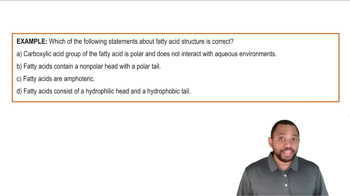Identify the components (1 to 6) contained in each of the following lipids (a to d):
1. glycerol
2. fatty acid
3. phosphate
4. amino alcohol
5. steroid nucleus
6. sphingosine
d. triacylglycerol
 Verified step by step guidance
Verified step by step guidance Verified video answer for a similar problem:
Verified video answer for a similar problem:



 1:52m
1:52mMaster Triacylglycerols Concept 1 with a bite sized video explanation from Jules
Start learning